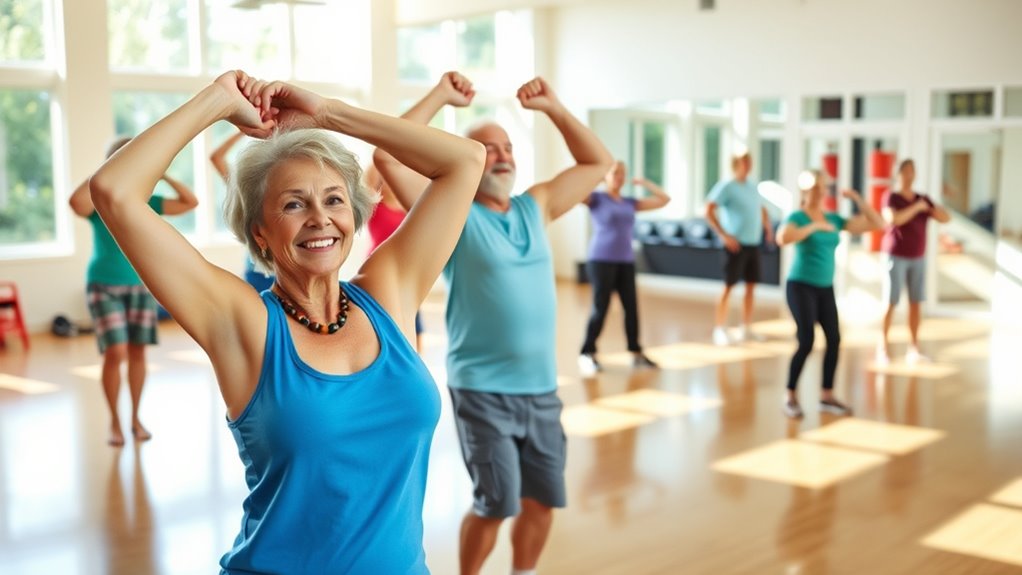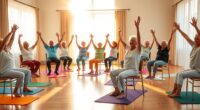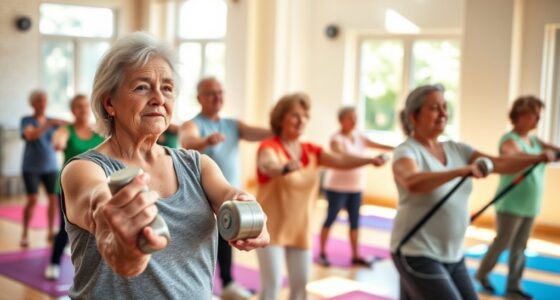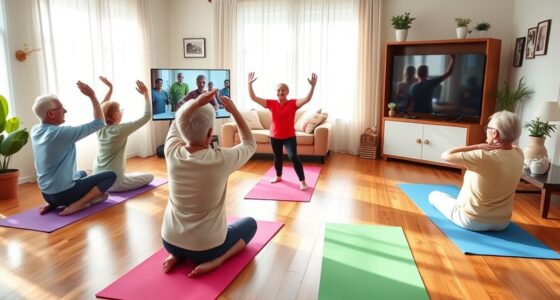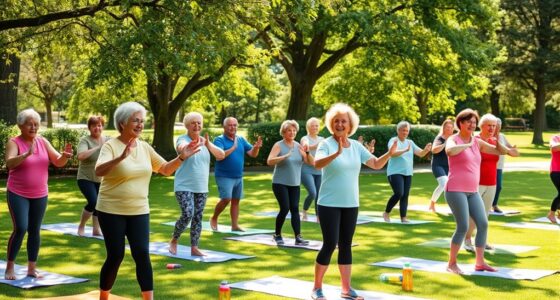A full-body workout for seniors boosts strength and mobility, making daily life easier and more enjoyable. Start with warm-ups like marching in place to increase blood flow. Focus on lower body exercises such as mini squats and step backs for stability. Incorporate upper body workouts, including shoulder presses and bicep curls, using light weights. Don’t forget core engagement exercises to enhance balance. Finish with gentle cool-down stretches. There’s much more to discover to help you stay strong and active.
Key Takeaways
- Engage in strength training at least twice a week to maintain muscle strength and enhance overall health as you age.
- Incorporate dynamic stretching and gentle warm-up exercises to prepare your body and prevent injuries before workouts.
- Focus on lower body strengthening techniques like mini squats and step backs to improve mobility and balance for daily activities.
- Include upper body exercises such as shoulder presses and bicep curls, using light weights to enhance strength safely.
- Stay consistent with your routine, gradually increasing weights, and prioritize hydration to support muscle function and overall performance.
Importance of Strength Training for Seniors
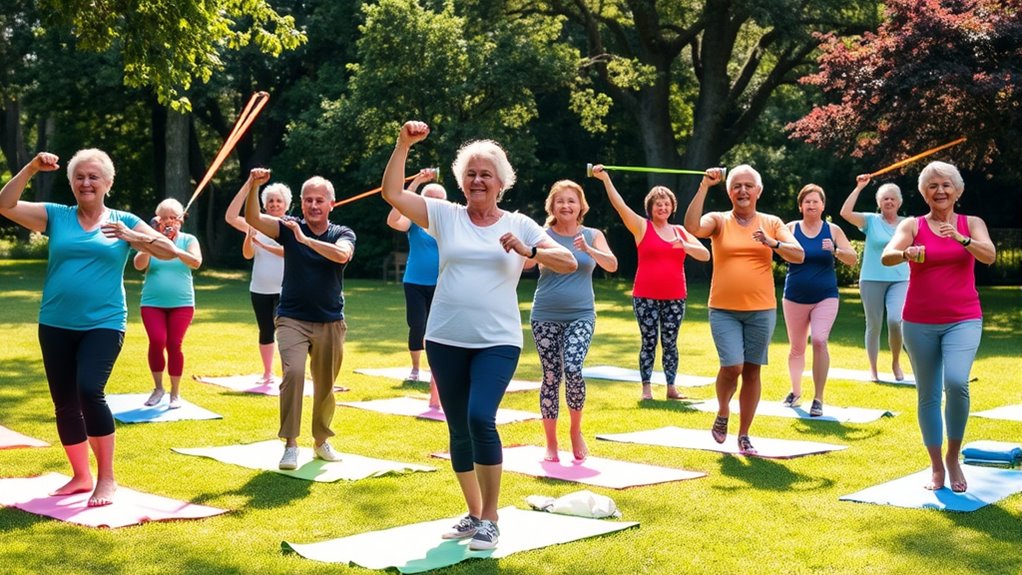
As you age, maintaining your strength becomes increasingly essential to keep your independence and overall health. Strength training is vital for combating muscle decline, which can occur at a rate of 3-8% per decade. By engaging in strength training at least twice a week, you can improve your muscle strength, balance, and bone density, greatly reducing your risk of falls and fractures. Additionally, cookies used for tracking can provide insights into how regular physical activity influences overall health outcomes. Implementing the art of decluttering strategies can also create a more focused and productive environment for your workouts.
Research shows that hydration is crucial for enhancing muscle function and overall physical performance in seniors. You don’t need fancy equipment; items like dumbbells, water bottles, or cans work just fine. Plus, proper strength training enhances your metabolic health, aiding in weight management. Additionally, incorporating comprehensive hearing evaluations into your health routine can help you stay aware of your auditory health, which is crucial as you age. Regular physical activity, including strength training, can help mitigate brain fog and improve overall cognitive function as you age.
Effective Warm-Up Techniques
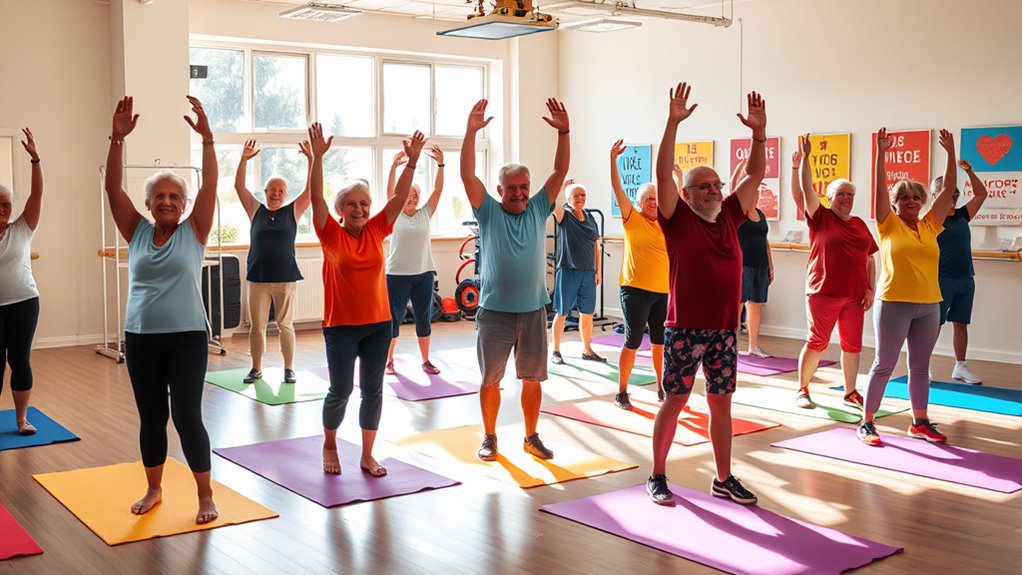
Warm-ups are essential for preparing your body for exercise and preventing injuries. Incorporating dynamic stretching exercises, like marching in place and side steps, can boost your flexibility and circulation. Additionally, listening to music during your warm-up can enhance your focus and concentration and make the experience more enjoyable. It’s important to remember that critical periods in physical development can influence how effectively seniors can engage in exercise routines. Creating cozy spaces for seniors to exercise can greatly improve their motivation and comfort during workouts. Additionally, ensuring a safe sleep environment can help seniors recover better, which may enhance their overall fitness performance. Engaging in somatic therapy techniques can also support seniors in connecting with their bodies and improving their overall movement quality.
Importance of Warm-Ups
A solid warm-up is essential for seniors before any workout. Effective warm-up techniques, like marching in place and mini squats, get your muscles ready for exercise, promoting blood flow and flexibility while reducing injury risk. Engaging in dynamic movements such as side steps and heel touches activates various muscle groups, boosting your overall mobility. Additionally, incorporating cold medications can help manage any discomfort that might arise during physical activity. Regular warm-ups are especially important for managing behavioral issues as they foster a sense of routine and well-being.
Incorporating energy-saving features into your routine can enhance your overall fitness experience and efficiency. Don’t forget to include arm circles and shoulder rolls; they relieve tension and enhance your upper body’s range of motion. Spending at least 5-10 minutes on these warm-up techniques not only guarantees your safety but also improves performance during strength training. Furthermore, regular warm-ups are an important part of elderly care that can significantly improve your physical well-being.
With increased muscle readiness and focus, you’ll achieve better form and technique, making your fitness routine both safe and effective. Additionally, incorporating regular exercise into your routine is critical for maintaining a healthy weight and preventing behavioral issues in dogs.
Dynamic Stretching Exercises
Dynamic stretching exercises serve as an excellent way to prepare your body for a workout, ensuring your muscles are primed and ready. Incorporating movements like marching in place, side steps, and mini squats warms up your muscles by increasing blood flow and flexibility. Additionally, performing these movements can improve your color accuracy in strength training by reinforcing good posture. Engaging in mindfulness practices can further enhance your awareness of your body during these warm-up routines. Moreover, incorporating dynamic stretching exercises can help improve overall mobility, making it easier to transition into more intense workouts. Regular air purifier maintenance can also contribute to a healthier environment for your workouts.
Engaging in functional movements, such as heel touches and side punches, can enhance your coordination and balance, making everyday activities easier. Spend at least 5-10 minutes on dynamic stretching exercises before your workout to reduce the risk of injury and improve your overall performance.
Focus on proper form to activate multiple muscle groups and reinforce good posture, which is essential for strength training. These active warm-ups lead to improved range of motion, setting you up for success. Additionally, practicing high vibrational energy during your warm-up can help align your mindset for a more effective workout.
Comprehensive Lower Body Exercises
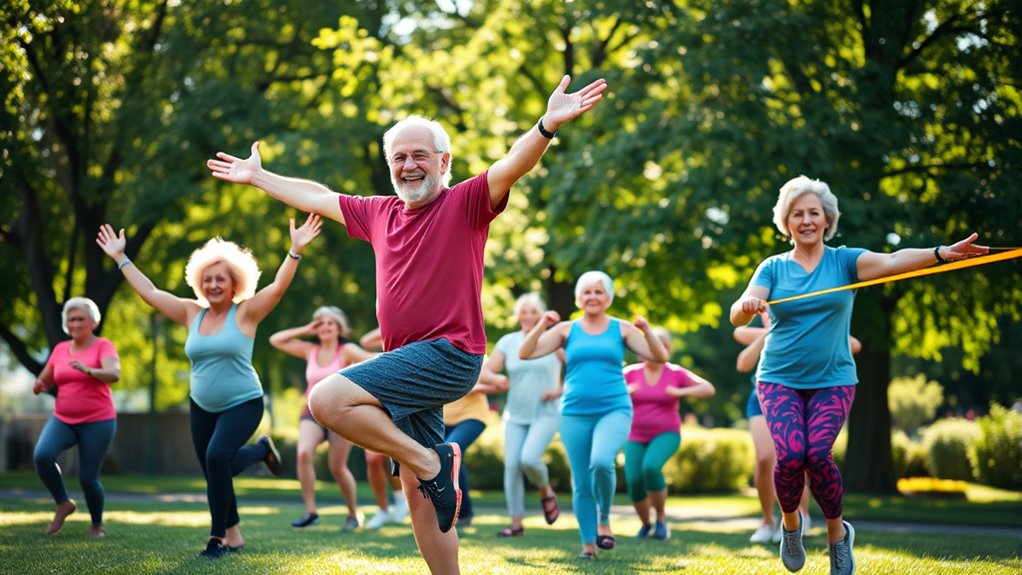
To strengthen your lower body, mini squats and step backs are great exercises to incorporate into your routine. These movements not only build muscle but also enhance your mobility for daily activities. Additionally, practicing Leave No Trace principles can help you maintain a safe and clean environment during outdoor workouts. Let’s explore how to perform these exercises effectively and safely. Additionally, incorporating time management skills can help you schedule regular workout sessions, ensuring consistency in your fitness journey.
Effective Mini Squats
Mini squats pack a powerful punch when it comes to strengthening your lower body and enhancing balance. These fundamental exercises help you build muscle in your legs, making everyday tasks like standing up from a chair or climbing stairs easier.
To perform mini squats, keep your back straight and knees behind your toes while lowering your body to a comfortable height. Start with bodyweight squats, and as you gain strength and confidence, consider adding light weights of 5 to 10 pounds.
Aim for 10 to 15 repetitions per set, completing 2 to 3 sets to effectively engage your lower body muscles. By incorporating mini squats into your routine, you can counteract age-related muscle decline and maintain your independence.
Step Back Techniques
Step back techniques are an excellent way to strengthen your lower body while enhancing balance and stability.
To perform a step back, stand upright and step backward with one foot, keeping your front knee aligned over your ankle. This move engages your glutes, quadriceps, and hamstrings effectively.
Enhance muscle engagement by incorporating mini squats with each step back, aiming for 10 repetitions on each leg. For an added challenge, consider using light weights of 5 to 10 pounds during these exercises.
By practicing step back techniques regularly, you’ll not only build muscle strength but also improve functional movements, making daily activities easier and safer.
Aim for two to three strength sessions per week to see the best results.
Upper Body Strengthening Workouts
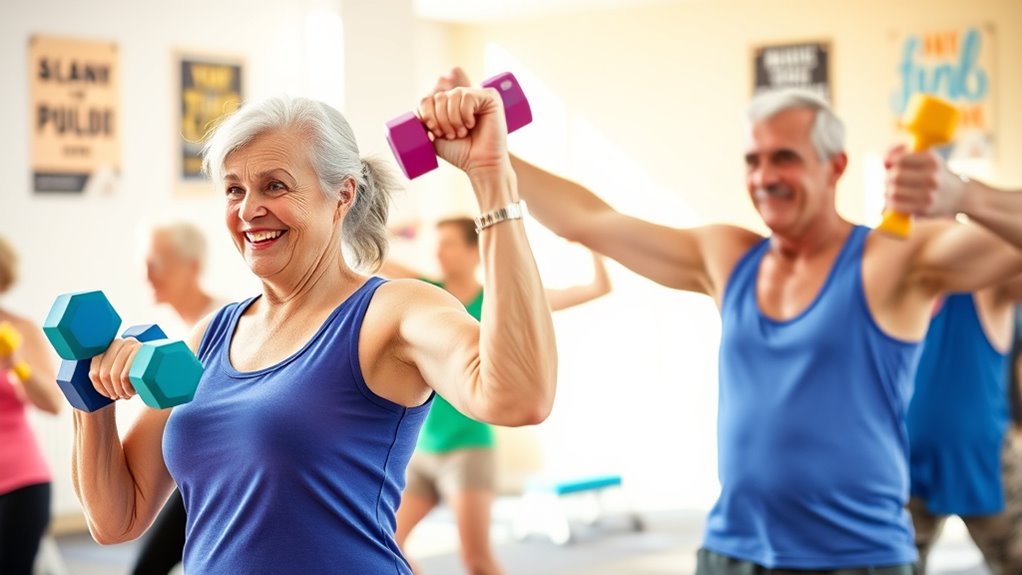
Upper body strengthening workouts are essential for seniors looking to maintain their independence and improve daily functioning. Incorporating exercises like shoulder presses, bent over rows, tricep extensions, and bicep curls helps build strength effectively.
Start with lighter weights, around 2-3 pounds, and gradually increase to 8 pounds as your strength improves. Remember to maintain proper posture and good form to maximize effectiveness and minimize injury risks.
Begin with light weights of 2-3 pounds, increasing to 8 pounds as you gain strength while ensuring proper form.
Breathing techniques are vital too; exhale during exertion and inhale during recovery to optimize performance. Aim for consistent training at least twice a week to combat muscle decline and enhance your functional capabilities.
With dedication, you’ll notice improvements in your everyday activities and overall well-being.
Core Engagement and Balance Exercises
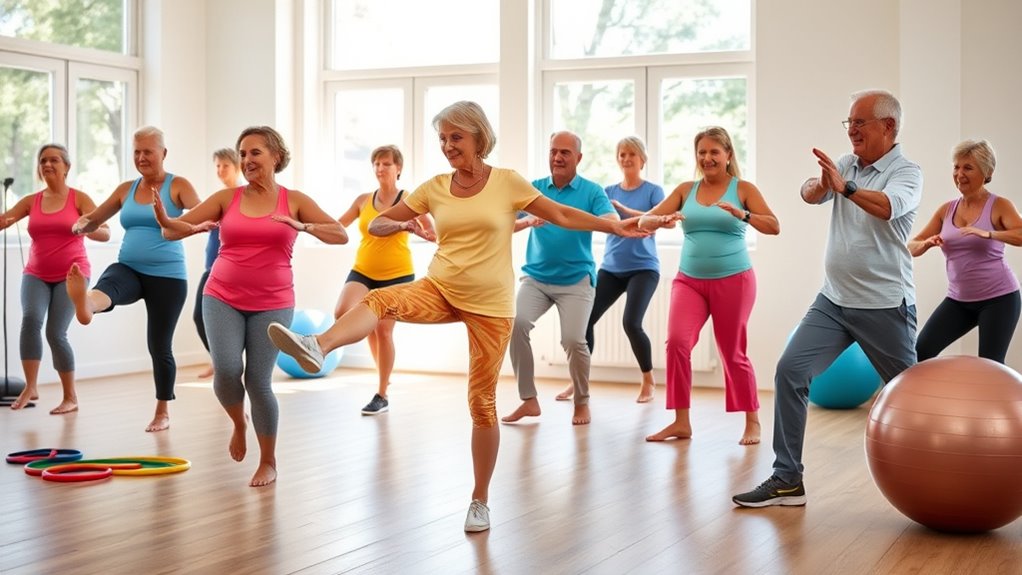
Building on the strength gained from upper body workouts, core engagement and balance exercises play an important role in enhancing your stability and overall functionality.
Exercises like pull-downs and knee raises strengthen your abdominal and oblique muscles, vital for daily activities. Start with bodyweight movements to focus on proper form before using light weights, around 3 pounds, to activate your core further.
Incorporate circular movements while engaging your core to target both your abs and arms, promoting better posture and reducing fall risks. For best results, perform each core engagement and balance exercise in sets of 10 repetitions on each side.
This gradual approach helps improve your strength and stability, making everyday movements easier and safer.
Essential Cool Down and Stretching Practices
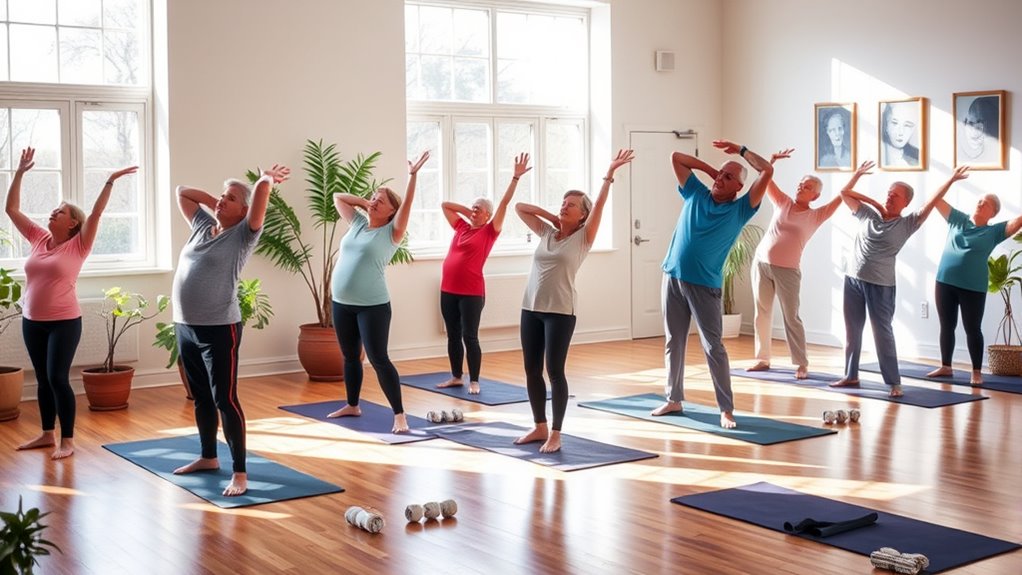
As you wrap up your workout, incorporating essential cool down and stretching practices is vital for your recovery and injury prevention.
These gentle stretches help maintain your body strength and enhance flexibility. Focus on hamstring and shoulder stretches, holding each for 15-30 seconds while practicing controlled breathing. This will reduce muscle tension effectively.
You can also perform arm circles and wide arm stretches to alleviate tension in your upper body and promote relaxation after strength training.
Frequently Asked Questions
What Is the Number One Exercise for Seniors?
The number one exercise for you as a senior is walking. It’s low-impact, easy to do, and fits any fitness level. Walking boosts your cardiovascular health and enhances mobility, making it an ideal choice.
To round out your fitness routine, consider incorporating strength training exercises, balance work, and flexibility stretches. This holistic approach can help you stay active, independent, and improve your overall quality of life as you age.
What Is the 6 12 25 Rule?
The 6 12 25 Rule‘s a straightforward guideline that helps you structure your strength training.
You’ll focus on 6 different muscle groups, performing 12 repetitions for each. After completing a set, take a rest of 25 seconds.
This method guarantees you work all major muscle areas while promoting endurance and recovery.
What Is the Easiest Full Body Exercise?
The easiest full body exercise you can do is the bodyweight squat. It engages your legs, core, and back, improving your strength and balance.
You can also try marching in place, which boosts your cardiovascular fitness.
Seated leg lifts are great for strengthening your lower body without straining your joints, while wall push-ups enhance upper body strength.
Incorporating light resistance, like water bottles, can make these exercises even more effective and enjoyable.
Can a 70 Year Old Get Back in Shape?
Absolutely, you can get back in shape at 70!
Start by engaging in strength training at least twice a week. Use light weights, gradually increasing as you build strength. Incorporate functional exercises like mini squats and lunges to improve balance and mobility.
Focus on core engagement and proper breathing during workouts. With consistent effort and a balanced routine that includes warm-ups and stretching, you’ll notice significant improvements in your fitness and overall well-being.
Conclusion
Incorporating a full-body workout into your routine isn’t just beneficial; it’s essential. Did you know that regular strength training can reduce the risk of falls by up to 40% for seniors? Imagine feeling more stable and confident in your movements. By engaging in these exercises, you’re not just building muscle; you’re enhancing your quality of life. So, embrace these workouts, and take charge of your health—your future self will thank you for it!
